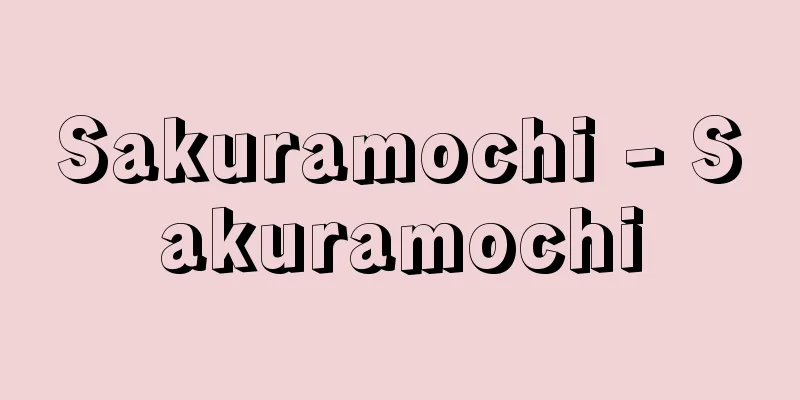Sakuramochi - Sakuramochi

|
This is a rice cake confectionery wrapped in salted young cherry leaves. The aroma of the leaves is transferred to the rice cake, and its elegant appearance is a taste of spring, which has been popular among common people since the Edo period. The most famous is the sakura mochi of Chomei-ji Temple in Mukojima, Tokyo, which has remained popular for over 250 years to this day. Chomei-ji sakura mochi began during the Genroku period (1688-1704) when Yamamoto Shinroku, who came from Choshi (Chiba Prefecture) and took up residence as the gatekeeper of Chomei-ji Temple, treated people visiting the temple's grave to homemade sakura mochi. In 1717 (Kyoho 2), when more cherry trees were planted along the banks of the Sumida River, a teahouse was built, and by 1824 (Bunsei 7), 775,000 cherry leaves had been used, and the number of sakura mochi sold reached 387,500 (Toen Shosetsu). Initially, non-glutinous rice was used for the skin encasing the strained bean paste, but this was later replaced by kuzu starch, and now wheat flour is used. One kilogram of flour is enough to make 100 skins, and the method is to knead wheat flour, bake it on a copper plate, wrap the stiffly kneaded strained bean paste in this, and then wrap it in two cherry leaves. A distinctive feature of Chomei-ji's sakura mochi is that the skin is not colored. Chomei-ji is the first to have written records of sakura mochi as a commercial product, but it is thought that the use of salted cherry leaves existed before that. It is likely that sakura mochi, along with kusamochi and kashiwa mochi, was made at home even earlier. Sakura mochi skins made from Domyouji rice cakes, which are light pink in colour, also have a pleasant texture. There is also a method of wrapping the mochi in leaves before steaming it. This method is more homely and appears to be older. [Fumio Sawa] [Reference] |Source: Shogakukan Encyclopedia Nipponica About Encyclopedia Nipponica Information | Legend |
|
塩漬けした桜の若葉でくるんだ餅菓子。葉の香気が餅に移り、その淡雅なようすが春の味わいとして、江戸時代から庶民に親しまれてきた。もっとも有名なのは東京・向島(むこうじま)にある長命寺(ちょうめいじ)の桜餅で、250年余の人気を今日も保っている。長命寺の桜餅は、元禄(げんろく)年間(1688~1704)に銚子(ちょうし)(千葉県)から出てきた山本新六が長命寺の門番に住み着き、墓参の人を手製の桜餅でもてなしたのに始まる。1717年(享保2)、隅田川堤に桜の植え足しが行われたのを機に茶屋がけしたのがあたり、1824年(文政7)に使用した桜の葉は77万5000枚、商った桜餅の数は38万7500個(『兎園(とえん)小説』)に達したという。この桜餅は当初漉し餡(こしあん)を包む皮に粳米(うるちまい)を用いたが、のち、葛粉(くずこ)にかわり、現在は小麦粉が使われている。粉1キログラムで100個分の皮をつくるが、製法は、小麦粉を練って銅板で焼き、これで固練りの漉し餡をくるみ、桜の葉2枚で包む。皮は着色しないのが長命寺の桜餅の特徴である。商品として文献に現れた桜餅は長命寺が古いが、桜の葉を塩漬けにした利用法は、それ以前からあったと考えられる。草餅、柏餅(かしわもち)などとともに家庭でつくられた年代は、さらに古いのではないだろうか。桜餅の皮は、道明寺種(どうみょうじだね)を使用し薄紅色をつけたものも口あたりがよい。また、葉にくるんでから蒸す仕法がある。このほうが家庭的であり、古いようである。 [沢 史生] [参照項目] |出典 小学館 日本大百科全書(ニッポニカ)日本大百科全書(ニッポニカ)について 情報 | 凡例 |
>>: Sacramento (English spelling) Sacramentum; sacrament
Recommend
Kibana Lupin - Kibana Lupin
...They generally contain poisonous alkaloids, bu...
Sanforizing - Sanforizing (English)
Fabrics made from cellulose fibers shrink when was...
Train
A self-propelled electric railcar that carries pa...
Candied
Seeds, fruits, and vegetables are pickled in sugar...
Dalbergia melanoxylon (English spelling) Dalbergia melanoxylon
… [Ken Ogata]. . … *Some of the terminology that ...
Eliza Orzeszkowa
1841‐1910 A representative Polish positivist novel...
La bohème
Puccini's four-act opera, composed to a libret...
Kanamori Yoritoki (■1)
...Modern daimyo. Sadachika, the son of Sadayori,...
《Uraha》 - Uraha
…Naturally, a guest of honor was often chosen for...
Bureaucrat - Kanryo
Narrowly speaking, it refers to a person (group) i...
Giant stink bug - Giant stink bug
...The sugarcane long-winged bug, Cavelerius sacc...
drachma
…Because silver was produced in large quantities ...
Hu Wei - Koi (English spelling)
Born: 1633 [Died] Kangxi 53 (1714) A scholar from ...
Naoie Ukita
Year of death: February 14, 1581 (March 18, 1581) ...
Loanable funds theory
A theory of interest rate determination that posi...









